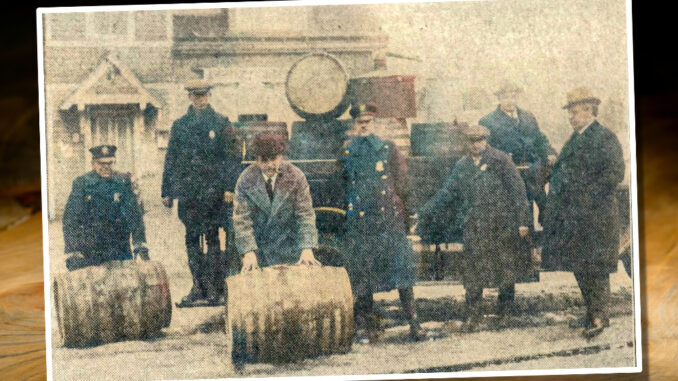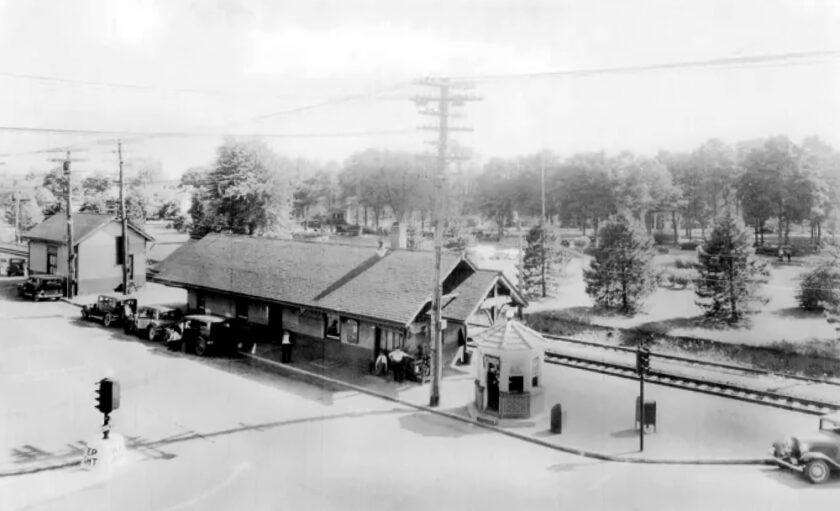
WESTWOOD—A century ago, a drunken brawl in downtown Westwood led officials to an illicit distillery disguised beneath a chicken coop. We go back to the days of Prohibition for this story, which begins outside the Westwood train station on the night of Sunday, Jan. 11, 1925.
Two men, one of whom had apparently had too much to drink, got into an argument near the intersection of Broadway and Westwood Avenue. Slurred insults turned into punches and the men got into a fistfight.
It was early days for the Westwood Police Department: the force consisted of just a few men, there was no motor patrol, and the center of law enforcement operations was an octagonal police booth that stood at Broadway and Westwood Avenue. Had an officer been inside the booth at the time, he might have seen the fight for himself. However, at that late hour on a cold January night, the booth was unmanned.
Someone who heard the fracas telephoned Mayor Irving T. Brickell, who called upon Special Policeman Barney Greeves. They arrested the intoxicated man on charges of disorderly conduct, fined him $15, and Mayor Brickell questioned him about where he had been drinking that night.
This was during Prohibition, the era between 1920 and 1933 when the sale of alcohol was illegal across America. Of course, people’s taste for drink, and their willingness to pay for it, persisted despite what the law said. Illicit distilleries of all sizes were set up in the rural outskirts of Pascack Valley towns during the Roaring Twenties, using derelict barns and vacant farmhouses as cover.
Brickell was on a crusade to rid the borough of bootlegging. He led many raids in pursuit of underground operations during his tenure, waging war on anyone who would violate the dry laws in Westwood. The fight outside the rail station was just the sort of lead he was looking for. The mayor learned that the man had obtained his drink at a place called the V.M. road house, a tavern on Old Hook Road in Westwood near the Emerson border. He sent policeman Victor Butterfield in plain clothes to investigate. Butterfield purchased a drink there.
The following day, Mayor Brickell, with Policemen Butterfield, Bartz, and Frontera, raided the V.M. and arrested the proprietor. They confiscated 50 bottles of wine from the cellar and fined the hotel owner $150. Further proceedings were dropped on the owner’s promise that he would stop selling liquor.
You might now be thinking that those Westwood officials of yesteryear were pretty naiive to believe a promise like that. In truth, they were watching the V.M. like hawks, just waiting for the owner to step out of line. It didn’t take very long:
On Jan. 17, 1925, five days after the initial raid, Brickell and the officers paid another visit to the road house on a tip. It was a Saturday night around 10:30, and inside the V.M., they found the owner’s wife serving liquor to a small party.

What followed was an extensive search. In the cellar they found several new bottles of wine in the same place where the stock had been discovered on the previous visit. They searched the barn, but did not find anything.
The men then investigated the chicken coop. In one corner, when the mayor brushed aside some straw with his shoe, he discovered a trap door. The hatch gave access to a sealed cellar where seven large barrels of wine were concealed. The amount of liquor in the barrels was estimated to be about 400 gallons.
There was also a still with a capacity of 20–30 gallons. The mayor and his crew were at the V.M. until well after midnight, and the barrels were brought to the borough hall on Center Avenue using fire trucks. It took two trips to bring it all in.
This time, the wife was arrested and fined $175. The couple, who had come to borough hall for processing, could only watch as their $4,000 worth of booze (over $70,000 in today’s money) was disposed of by being poured into the gutter on Center Avenue.
About Prohibition
The Prohibition era in the United States lasted 1920–1933, during which the production, importation, transportation, and sale of alcoholic beverages were banned.
This prohibition was instituted by the Eighteenth Amendment to the Constitution, ratified on Jan. 16, 1919, and enforced through the Volstead Act. The movement to curtail the alcohol industry began with state-level restrictions before becoming a federal mandate.
Prohibition ended on Dec. 5, 1933, with the ratification of the Twenty-first Amendment, which repealed the Eighteenth Amendment, restoring legal alcohol production and sales.
